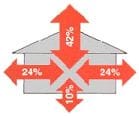
Insulation is the most overlooked factor in Australian homes. Yet when chosen carefully and properly installed, it can keep you up to 10 degrees warmer in winter, 7 degrees cooler in summer and significantly reduce noise, making you and your family more comfortable all year round.
If that isn't enough, it will also save as much as 60% of your current energy bills - enough to pay for itself in 3-4 years and add to the real estate value of your home.
 'Thermal mass' describes the potential of a material to store and re-release thermal energy. Materials with high thermal mass, such as concrete slabs, can help regulate indoor comfort by acting like a temperature flywheel: by radiating or absorbing heat, they create a heating or cooling effect on the human body.
'Thermal mass' describes the potential of a material to store and re-release thermal energy. Materials with high thermal mass, such as concrete slabs, can help regulate indoor comfort by acting like a temperature flywheel: by radiating or absorbing heat, they create a heating or cooling effect on the human body.
'Thermal mass is useful in most climates, however to be effective it must be used in conjunction with good passive design.'
Á slabs should be designed so that in winter it can absorb heat from the sun (or other low energy sources). This heat is stored by the thermal mass and re-radiated for many hours afterwards.
Slab design should also ensure that in summer it is protected from direct sunlight during the day, but is still exposed to cooling night breezes and night sky radiation so that heat collected during the day can dissipate.
An uninsulated slab in a good passively designed house has a surface temperature approximately the same as the stable ground temperature at about 3m depth. Ground coupling in mild climate zones such as Geraldton allows the floor slab of a well insulated house to achieve the stable temperature of the earth: cooler in summer, warmer in winter. In winter, added solar gain boosts the surface temperature of the slab to a very comfortable level.
 Proven Comfort
Proven ComfortWhen it comes to a comfortable living environment your home can be your worst enemy. Take those freezing winters. 42% of your home's warmth is lost through the ceiling and 24% is lost through the walls. It's the reverse on blazing hot summer days with heat flowing in through the ceiling and walls.
Insulation stops up to 70% of all heat transfers. Insulation gives you comfort and control all year-round.
 Thermal Resistance and Thermal Response
Thermal Resistance and Thermal ResponseThe performance of an insulation material is measured by its 'Thermal Resistance' or 'R-value'. Uninsulated building sections, such as walls or roofs, also have an R-value. The greater the R-value, the more effective is the insulation or building section at resisting heat flow, and therefore the greater the level of insulation provided. While the R-value is an important influence on the rate of heat loss and heat gain from a house, the thermal comfort inside a house is also affected by the 'Thermal Response' of the building materials used.
The comment is often made that "double brick is better" from the point of view of thermal comfort. However, when the R- values of the common wall types are compared, they are quite similar- uninsulated double brick (RO.50), uninsulated brick veneer (RO.46); and uninsulated weatherboard (0.46).
The R-value of the insulation and the R-value of the uninsulated building section can be combined to form the total thermal resistance (Rr) of the insulated building section.
The villas at The Lighthouse Estate have insulating R values as follows: